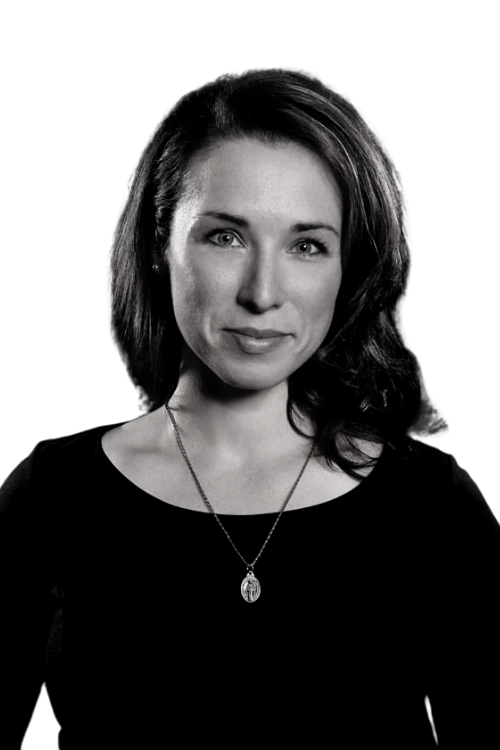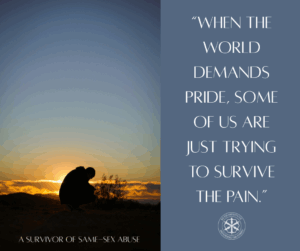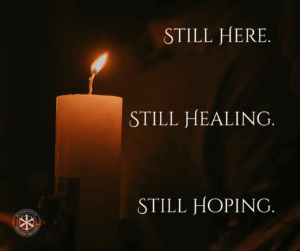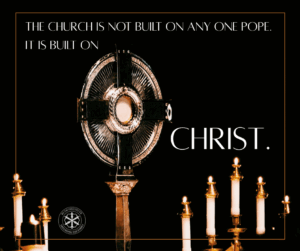Clergy Sex Abuse
For anyone who is aware of the sexual abuse scandal plaguing the Catholic Church, it is clear that it is not going away any time soon. Much has yet to be uncovered, in many cases justice has yet to be done, complete accountability has yet to be taken, and transparency is still grossly lacking.
While the scandal has undoubtedly affected everyone, survivors bear the brunt of the pain. Everyone should aim to provide all survivors with good, solid support systems that include family, friends, and the community. Here at the Ruth Institute, we are here to help.
Our Clergy Abuse Resource Page provides the necessary information and resources for survivors to feel more heard and supported. Here on our all-in-one index page, you can find materials offering the scientific, data-based, and story resources you need as a survivor or as a supporter of a survivor. We also have our Ask a Survivor blog (moderated by a clerical abuse survivor) which seeks to offer education and support to sexual abuse survivors and those who care for them.
For anyone aware of the sexual abuse scandal plaguing the Catholic Church, it’s clear this issue isn’t going away any time soon. Much has yet to be uncovered, and, in many cases, justice has yet to be served. Accountability and transparency are still grossly lacking.
While the scandal has affected many, survivors bear the brunt of the pain. Family, friends, and church communities should do what they can to support these survivors.
Our Clergy Abuse Resource Page provides data, real-life stories, and an FAQ written by clergy abuse victim, Faith Hakesley, author of our Advice from a Survivor blog.
The data, Facts, and Science
About Clergy Sex Abuse in America
Dr. Rev. Paul Sullins examines the data from the clergy sex abuse scandal. He does a deep dive into the data from the John Jay College of Criminal Justice report, the Pennsylvania Grand Jury report, and the correlation between the abuse and the number of self-reported homosexual men in the Priesthood. The video presentation provides a helpful overview of the problem of Catholic Clergy Sex Abuse: past events, present state, and emerging trends.
When we talk about Catholic Clergy Sex Abuse, we’re talking about a wave of misconduct that seems to have begun in the 1950’s, peaked somewhere in the mid 1980’s, and has declined since.
The blame starts at the abuser himself, usually a priest, but the problem goes deeper than that. For decades the elements of the heirarchy hid the behavior, fought the survivors in court, and shielded the guilty.
The USCCB Has taken some steps in the wake of the reports, but it would appear that not enough is being done, either in recognizing what the problem was in the 1980’s and what the problem is now.
You can review this data and share it with your friends. You can also…
Hear the stories of the silenced.
Receding Waves
Child Sex Abuse and Homosexual Priests since 2000
The data on Clergy Sex Abuse in America
Dr. Rev. Paul Sullins examines the clergy sex abuse data from the John Jay College of Criminal Justice report and the Pennsylvania Grand Jury report. He also cites a correlation between abuse and the number of self-reported homosexual men in the priesthood. The video below provides an overview of the problem: past events, present state, and emerging trends.
When we talk about Catholic Clergy Sex Abuse, we’re talking about a wave of misconduct that seems to have begun in the 1950’s, peaked somewhere in the mid 1980’s, and has declined since.
The blame starts at the abuser himself, usually a priest, but the problem goes deeper than that. For decades the elements of the heirarchy hid the behavior, fought the survivors in court, and shielded the guilty.
The USCCB Has taken some steps in the wake of the reports, but it would appear that not enough is being done, either in recognizing what the problem was in the 1980’s and what the problem is now.
You can review this data and share it with your friends. You can also review more of the FAQs below.
Hear the stories of the silenced.
Survivor Stories
Hear the stories of the silenced.
Clergy Abuse Survivor STories
Hear the stories of the silenced.
Hear the stories of the silenced.
News Media
- Loudon County Sex Abuse Response No Surprise To Catholics
- The Disturbing Case of Father Michael Guidry
- Cuomo Proves #MeToo Is Not Enough
- Reflections on Deflection: Msgr. Burrill's Resignation
- Trauma: Flash Floods and Childhood Sexual Abuse
- Sexual Abuse: Bigger in the Church or Society?
- Courageous Victims Speak Out
- What do Weinstein, Epstein, and McCarrick Have in Common?
- Abuse Victim Profile Changed After 2000
- Why the Change in Clergy Sex Abuse Since 2000 Matters
- Pope Emeritus Benedict Is Right: The Sexual Revolution is Part of the Problem
- Catholic Culture Change is a Good Thing
- Frederic Martel and the Vatican
- Weaponized Self Pity Part II: Gay Clergy
- There Is No Gay Purge
- More Defeatism
- Why I Won't Ask Pope Francis To Resign
- The Sexual Revolution Protects Sexual Predators
- About Those Gay Clergy Networks
- Punishing the Guilty is Justice, Not a Witchunt
- 3.5 Step Plan for Reforming the Church
- Combat Scandal with Rosary Around the World
- Become a Catholic Community Organizer
- How Ordinary Catholics Can Help Reform Their Church
- How to Help the Catholic #MeToo Movement
Ruth Institute Articles
Ask a survivor
Faith Hakesley, a survivor of clergy abuse, answers audience questions about the process of healing from clergy abuse. Discover the insights about recovering from abuse; what’s normal in recovery, how to move forward, and how loved ones can help.

Watch Dr. J and Faith Discuss "Ask a survivor"
Discover More from Faith...

When Pride Feels Like Pain: A Survivor’s Perspective
Every June, rainbow flags are hoisted high. Cities erupt in celebration. Schools, public libraries, corporations, and even some churches proudly join in what has become

When Grief and Hope Collide: A Personal Reflection on a New Pope
I had an unexpected reaction at Mass a couple of weeks ago. When our pastor mentioned the election of our new pope, I felt a

Francis is Gone. We Grieve but the Wounds Remain
With Pope Francis’s death comes a complex wave of grief. His pontificate leaves many wounds. Many people (Catholics and non-Catholics alike) are mourning a man
ADvice from a survivor
Faith Hakesley, a survivor of clergy abuse, shares her process of recovery and healing. Learn what’s normal in recovery, how to move forward, and how loved ones can help.

Watch Dr. J and Faith Discuss "Ask a survivor"
Discover More from Faith...

When Pride Feels Like Pain: A Survivor’s Perspective
Every June, rainbow flags are hoisted high. Cities erupt in celebration. Schools, public libraries, corporations,

When Grief and Hope Collide: A Personal Reflection on a New Pope
I had an unexpected reaction at Mass a couple of weeks ago. When our pastor
FAQs about Clergy Sex Abuse
What is clerical abuse?
Clerical abuse is the sexual assault, harm, and exploitation of an individual by a member of the clergy. Like any kind of abuse, clerical abuse usually involves a predator grooming his victim.
What is the grooming process?
Grooming is when an abuser selects and prepares his victim to be sexual abused. Predators deliberately, secretly, and gradually build relationships with their victims. They then manipulate that trust and may take control of every aspect of the relationship (mental, emotional, and spiritual).
Grooming is one of the reasons victims continue to trust and return to their abuser. Predators use gas lighting and other tactics to shift any blame onto the victim, creating a sense of self-doubt in the victim’s mind. Sometimes victims will even be made to feel sympathetic and compassionate towards their abuser. This can be a survival strategy for victims and is commonly found in toxic relationships, such as between a parent or child or a spiritual leader and their victim.
It’s important to note that grooming can be done to children and adults and can happen both in person and online.
What are some of the characteristics of the grooming process?
• A predator will carefully select his/her victim based on ease of access and how vulnerable that individual is perceived to be. For example, a child who is alone often will be an easier target than a child who is always with an adult.
• Selection then leads to slowly finding opportunities to isolate the victim.
• From there, the abuser gains the victim’s trust. The inappropriate touching doesn’t happen right away. It happens slowly over a period of time as the abuser proves himself or herself to be a trustworthy individual. A relative, teacher, priest, coach, or other person who is generally seen as a trusted individual more easily gains the trust of a victim.
• A predator will get the victim to keep secrets, starting with small ones like, “Don’t tell your mom I gave you candy,” and slowly build from there.
• An important aspect of grooming is desensitizing the victim to touch and to sensitive topics of a sexual nature. While the “bad touch” doesn’t usually happen right away, the abuser will slowly add touch to the relationship. The seemingly innocent touches on the shoulder or head slowly grow into something more sinister, aggressive, and sexual. Predators will try to make these behaviors seem normal and, if the victim resists, the predator will place blame on the victim or make the victim feel as if he or she is overreacting.
• Predators will often maintain the relationship for a long period of time and continue controlling their victim by various methods including secrecy, guilt, blame, threats, and gifts.
• Predators often groom families and communities as well.
What are the effects of clerical abuse on victims? Why is it so damaging?
Like any kind of abuse, clerical abuse can have lasting physical, emotional, and spiritual effects. Survivors may experience PTSD, anxiety, flashbacks, depression, isolation, problems with their spiritual lives, and difficulty maintaining healthy relationships.
Clerical abuse, or any kind of abuse that happens at the hands of a trusted individual who is an authority figure, happens in an environment where the victim has a reasonable expectation to trust that the priest will do only what is right. When a member of the clergy dishonors his position, he hurts victims and the entire church.
What should I do if I am a victim of clerical abuse? What should I do if someone I love has been a victim?
First of all, abuse is never your fault. Second, you are not alone. Please reach out for the help and support you need.
Some steps you can take include:
• Call 911 if the assault has just happened. Otherwise, if some time has passed since the crime occurred, file a police report with local law enforcement (or wherever the abuse occurred). Ask the department if they have someone who specializes in abuse cases.
• If you have just been assaulted, you can go to your local hospital and ask for a sexual assault forensic exam (also known as a rape kit). If possible, you should not wash any evidence off your body or change your clothes. This will ensure that as much evidence as possible can be collected. Rape kits can provide crucial evidence if your attacker is prosecuted and can also help to identify perpetrators in cases where he/she is unknown to the victim.
• Call your local Child Protective Agency or an abuse hotline. Child Help Hotline is one option. You can call or text 1-800-4-A-CHILD (1-800-422-4453) or go to the website and chat with a live representative.
• If you are a victim of clergy abuse, you can report it to the USCCB (United States Conference of Catholic Bishops). The number for the Secretariat for Child and Youth Protection is 202-541-5413. You can also report to the Victim Assistance Coordinator within the diocese. In addition to reporting to the diocese where the abuse occurred, you can also report to any other locations you know the abuser has been located.
• If the abuser was a bishop, or if you believe a bishop has covered abuse, you can call The Catholic Bishop Abuse Reporting Service (CBAR) at (800) 276-1562 or visit ReportBishopAbuse.org.
• If you are in fear of your abuser, look into a Civil No-Contact Order or a Civil Restraining Order. Contact your local law enforcement agency or courthouse for more information.
• Seek out a trauma counselor or mental health professional who specializes in trauma or sexual assault as soon as possible. This is an important step for victims to get the help and support they need, but it’s also important for those who are trying to support victims. There are resources online for obtaining a Catholic or Christian counselor if that is your preference.
• Trauma can have devastating consequences particularly in regard to personal wellness and safety. If you or a loved one is in severe distress and in danger of self-harm, call the National Suicide Prevention Hotline at 1-800-273-8255.
For various reasons, survivors might not feel comfortable getting their church involved. That’s okay! If you would rather speak to someone not directly affiliated with the Catholic Church, here are two options, with others available online:
Tentmakers: a non-profit dedicated to fostering hope, healing, and justice for survivors of clergy abuse.
What can I say to someone who has endured abuse?
Sometimes the best response is simply, “I believe you” and then listen to them. Asking them how you can help them can be helpful as well. Avoid asking too many questions especially ones that place blame on the victim such as, “Why didn’t you come to me sooner?” If you do have questions, you should consult a reputable professional source or seek counseling. The important thing to remember is that, while you can support and help a victim, you can’t fix it for them.
Can I report/discuss clerical abuse and still be a good Catholic/Christian/Religious person, or would I be committing a sin of scandal?
You can and should report abuse. It is not scandal. According to the Catechism of the Catholic Church, “scandal is an attitude or behavior which leads another to do evil. The person who gives scandal becomes his neighbor’s tempter. He damages virtue and integrity; he may even draw his brother into spiritual death. Scandal is a grave offense if by deed or omission another is deliberately led into a grave offense.” (CCC 2284) Just from this definition alone, it is clear that the abuser is the one who has created scandal.
One of the Seven Spiritual Works of Mercy is “admonishing the sinner” which implies a call to repentance and reconciliation. Admonishment can help the sinner experience forgiveness and healing in Christ. Turning predators in and helping to bring awareness to corruption within any church helps to protect victims, prevent future victims, and is one way to admonish abusers for their sins. Staying silent creates further scandal because it allows predators to continue abusing. Not enabling someone’s bad behavior is a Spiritual Work of Mercy.
I worry that bringing up allegations of abuse will tarnish the reputation of the Church. Will it?
Our first concern should always be caring for the victims. Bringing abuse to light helps victims and the church community heal.
The blame should always lie with the abuser. In the case of clerical abuse, the priest is the one who dishonored his position and sullied the good name of the church with his actions. If his superiors knew about it and covered for him, they, too, are culpable.
It’s important to keep in mind that the Catholic faith is not synonymous with its people. Within the Church are flawed human beings. The blame is on them, not Catholicism or the whole of the Catholic Church itself.
Is sexual abuse limited to the Catholic Church?
No, abuse is not limited to the Catholic Church. Every religious organization has issues with sexual abuse. A report issued by Christian Ministry Resources in 2002 stated that there are more allegations of child sexual abuse in Protestant congregations than Catholic ones, and that sexual violence is most often committed by volunteers rather than by priests.
What can I do to help with this issue?
First, support and listen to survivors, though their stories are not easy to hear. Abusers are oftentimes individuals we have trusted and held in high esteem, yet ignoring the issue helps no one.
Second, encourage survivors to report the abuse to the proper authorities (law enforcement as well as the church) and demand transparency, accountability, and justice.
Third, encourage survivors to seek help: physical, psychological, and/or spiritual.
Fourth, remind survivors that they are not alone, there is help for them, and there is always hope.
Why doesn’t the Catholic Church just let priests get married? That would fix the problem, wouldn’t it?
Allowing priests to marry would not fix the issue of clerical abuse. Here are some reasons why:
• The argument that celibacy is a primary factor in clerical abuse suggests that men can’t control their sexual urges and that the reason they rape is to “relieve” those urges. If celibacy was truly the issue, a priest could easily find an adult woman to have consensual sex with him. No normal adult male goes through the process of grooming an individual in order to take advantage of them. Also, many of the horrific things abusers have done, a rational person wouldn’t do to another human being (child or otherwise).
• The majority of clerical abuse victims have been male. Allowing priests to marry isn’t going to solve the problem of homosexuality in the priesthood.
• Married men sometimes abuse too, so there’s no guarantee a married priest wouldn’t as well.
Are homosexual priests a contributing factor in the sex abuse crisis?
More than 80% of the victims were male, and 78% were postpubescent. Father D. Paul Sullins, Ph.D., a senior research associate of the Ruth Institute, issued a report that found that the number of homosexual men in the priesthood rose from twice that of the general population in the 1950’s to eight times the general population in the 1980’s. This trend strongly correlated with increasing child sex abuse.
Fr. Sullins also noted that a quarter of priests ordained in the late 1960’s reported the existence of a homosexual subculture in their seminaries. This was a rise to over half of priests ordained in the 1980’s, yet another trend that was also strongly correlated with increasing child sex abuse.
What about false accusations of abuse? How can I be sure that a victim is telling the truth?
Unfortunately, false accusations do happen. This is one of the reasons why getting law enforcement involved is so important. However, more often than not, abuse allegations are credible. Sometimes predators are the people we least expect, so it’s important to keep an open mind. When in doubt, give the victim the resources they need, and allow law enforcement to do their job.
How can I prevent myself and my children from being victims?
Understand the grooming process. While grooming behaviors aren’t typically illegal, they can lead to criminal behaviors. If grooming is seen or suspected, report it to create more oversight of the suspected potential predator. For example, if a teacher seeks alone time with your child or give gifts, talk with the principal.
As a parent, be involved in your children’s lives. Talk to them about bad touch, boundaries, and keeping secrets. Be aware of who they are around, knowing potential predators could be the person you least expect.







